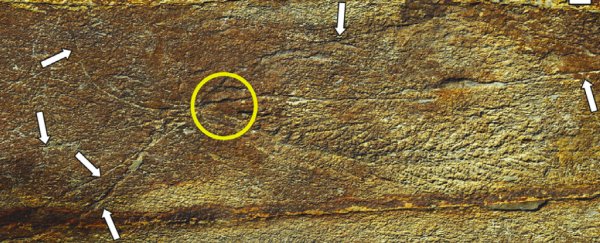Ancient fern-like creatures known as rangeomorphs might not have been as lonely as we once imagined. Filaments discovered in half-a-billion year old rocks in Newfoundland, Canada, suggest clusters of these early animals could have connected up through a network of thin fibres.
Exactly what these fibres did isn't all that clear. Suggestions range from shared anchors to prevent the animals that made them from washing away in currents, to pipelines for sharing nutrients, to a means of reproduction.
Palaeobiologists Alex Liu from Cambridge University and Frankie Dunn from the University of Bristol analysed a wide variety of the fossilised web of threads - discovered linking leaf-shaped impressions across dozens of rock beds in Newfoundland, Canada.
Most filaments were barely a fraction of a millimetre wide, and ranged from a couple of centimetres (nearly an inch) to around 40 centimetres (just over a foot) in length. There were a few stand-out examples of long-distance connections, with some thicker lines extending over four metres.
If not for the remarkable state of preservation in the fine sedimentary strata, the delicate lines would be easy to miss, which explains why nobody noticed them until now.
"It's incredible the level of detail that can be preserved on these ancient sea floors; some of these filaments are only a tenth of a millimetre wide," says Dunn.
The strange webs also varied extensively in how they were clustered, with some ranging out on their own, to hundreds of filaments crammed into every square metre and headed out in all directions, sometimes splitting, occasionally doubling back.
 (Liu & Dunn, Current Biology, 2020)
(Liu & Dunn, Current Biology, 2020)
Among the criss-crossing lines are a number of the more familiar shapes of various 'frondose' animal species, a handful clearly linked into this early organic internet. One stunning example shows two of the same species connected by a thread.
These feathery rangeomorphs are just one example of the Alice in Wonderland menagerie that popped up during the Ediacaran period, between 571 and 541 million years ago.
It's hard to really know what many of these prototype animals might have looked like in all their glory, not least because fossils only preserve the toughest of their tissues. The best we can do is hope to find footprints or burrows, to add context to their lives.
At a glance we'd probably mistaken this particular category of fern-bodied creatures for plants blooming out of the sea floor. They had flat, branching shapes that seemed to grip surfaces by a holdfast, implying they didn't move around.
Just how they might have fed is a mystery, given we have barely an imprint of their anatomy to go on. Perhaps there's a mouth in there somewhere, or if we make comparisons with modern animals, they could have used their fronds to filter material from the water - as corals and barnacles do today.
We do know that they probably reproduced asexually. But a lot of their lifestyle is a complete unknown. Until now, there was no evidence to hint at interactions, leading researchers to assume they had a rather solitary existence.
"We've always looked at these organisms as individuals, but we've now found that several individual members of the same species can be linked by these filaments, like a real-life social network," says Liu.
"We may now need to reassess earlier studies into how these organisms interacted, and particularly how they competed for space and resources on the ocean floor."
What is fairly clear is that their morphology was a winning formula at a time when primitive life was in an arms race to take over the world. Rangeomorphs were everywhere, with many fossil beds dominated by a single species. They also covered a broad diversity of sizes, from a couple of centimetres to metres in length.
The newly discovered threads might have given them some kind of edge, perhaps acting like the runners on strawberries, stretching out to sprout new generations further afield where they stuck around to help anchor them down or share nutrients.
 (Charlotte Kenchington/University of Cambridge)
(Charlotte Kenchington/University of Cambridge)
It's an interesting hypothesis that will no doubt be put to the test as we find more examples of these structures, perhaps uncovering examples of emerging 'infant' rangeomorphs.
Until that happens, we can only guess what kinds of communications – if any – were being channelled through these early social networks.
This research was published in Current Biology.
